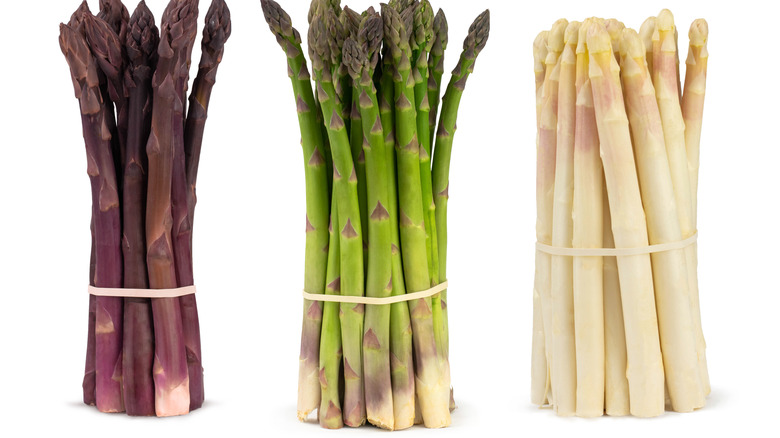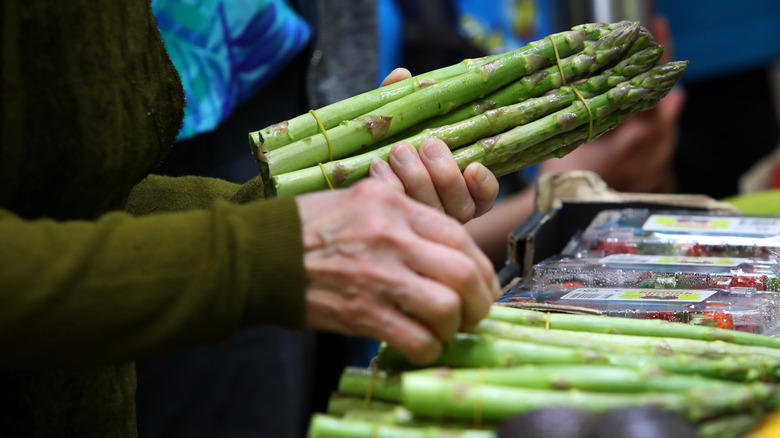Jacques Pépin's Brilliant Trick To Get The Most Out Of Asparagus Stalks
We may receive a commission on purchases made from links.
People spend a lot of time figuring out how to save money at the grocery store, especially now. Between coupon clipping, stocking up in bulk at warehouse stores like Costco, and buying generic, there are plenty of methods for stretching your dollars at the cash register. But the flip side of saving money that doesn't get nearly as much attention as it deserves is preventing food waste. Think of it this way — every time you throw away food that has gone bad in your refrigerator, you're throwing a few dollars away.
Food waste is a huge problem around the globe because it's not only bad for your wallet, it's bad for the environment. The Environmental Protection Agency reports that a third of all the food produced in the U.S. is never eaten, and Feeding America reports that 119 billion pounds of food is wasted in the United States alone each year, which is around $408 billion. Most uneaten food ends up in landfills, which emits more greenhouse gas than 42 coal-fired power plants (per the EPA).
Saving money and the environment is easy if you like to cook, however, you need only look to the example of a French chef like Jacques Pépin, who was mindful of food waste way before it was cool.
Pépin the penny pincher
When people think of Jacques Pépin, the first thing that comes to mind is his many cookbooks and TV shows. But almost as a rule, part of Pépin's whole brand and cooking style is his unglamorous way of using up all of the ingredients he has on hand. Jeff Gordinier, Food & Drinks Editor for Esquire, says that "Having endured the deprivations of World War II during his childhood in France, Jacques Pépin really doesn't like to throw stuff away—especially if an ingredient can be repurposed in a different dish." And on his most recent home cooking show on KQED, "Jacques Pépin Cooking At Home," he's often rescuing items like a random mushroom from the refrigerator and adding it to a dish (per The Takeout).
One of the ways that Pépin saves money and avoids food waste is by using asparagus stems. A lot of us were taught to prep asparagus by bending each piece until it naturally snaps to separate the softer upper part of the spear from the tougher part of the stalk, or just chopping off the stalks. And while those methods work, they also leave behind up to half of the bunch of asparagus that gets thrown away. Since asparagus can cost as much as $4 a pound (per How Much Is It), that's like throwing $2 in the trash if you're prepping a pound of asparagus for grilling with tonight's dinner.
Peel your spears
Rather than chop or snap off half your asparagus, Pépin says in his cookbook "A Grandfather's Lessons: In the Kitchen with Shorey" that you don't need to throw all of that good asparagus flavor away. Instead, use a peeler to remove the tougher skin on the outside of the lower part of your spears, leaving the tender interior behind for cooking.
To peel your asparagus spears, make sure you keep them intact (no chopping or snapping). Hold them on a flat surface like a countertop or cutting board with one hand, and use the other hand for holding the peeler. Now gently peel the lower half or so of the asparagus peel on all sides by peeling downward toward the bottom of the stalk (per Oprah). The very bottom of the stalk will still be pretty woody, so after you've finished peeling your pieces you can then trim off the bottom half inch.
But wait, don't toss those ends and peels so fast! You can use them for making asparagus soup, or you can save all your vegetable scraps for making veggie stock later on. According to The Baltimore Sun, Pépin does this by storing all of his vegetable trimmings in a milk carton in the freezer and uses them later on for mirepoix. Waste not, want not!


